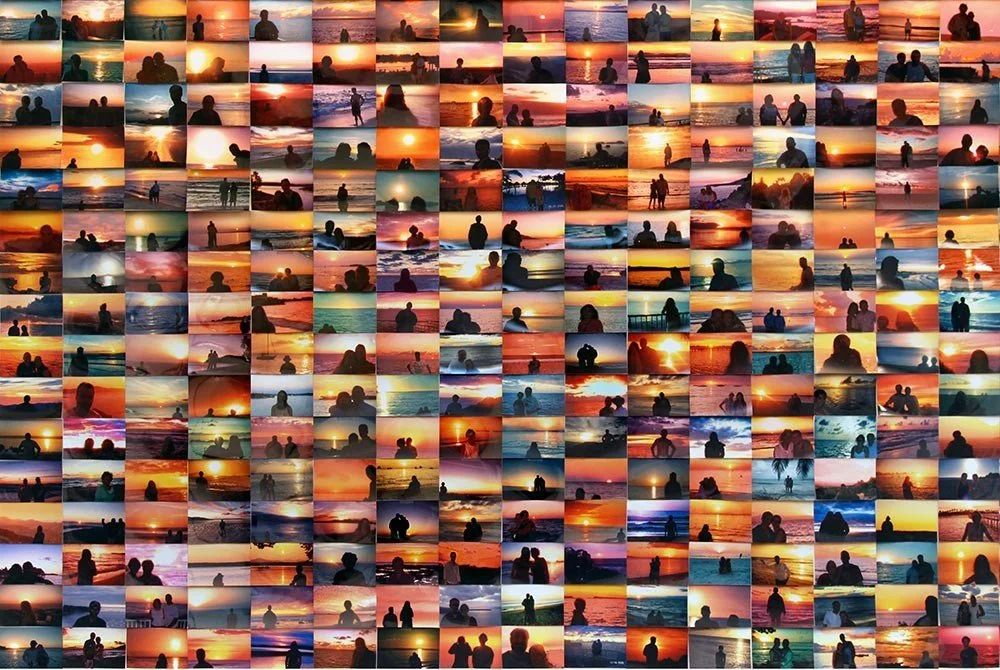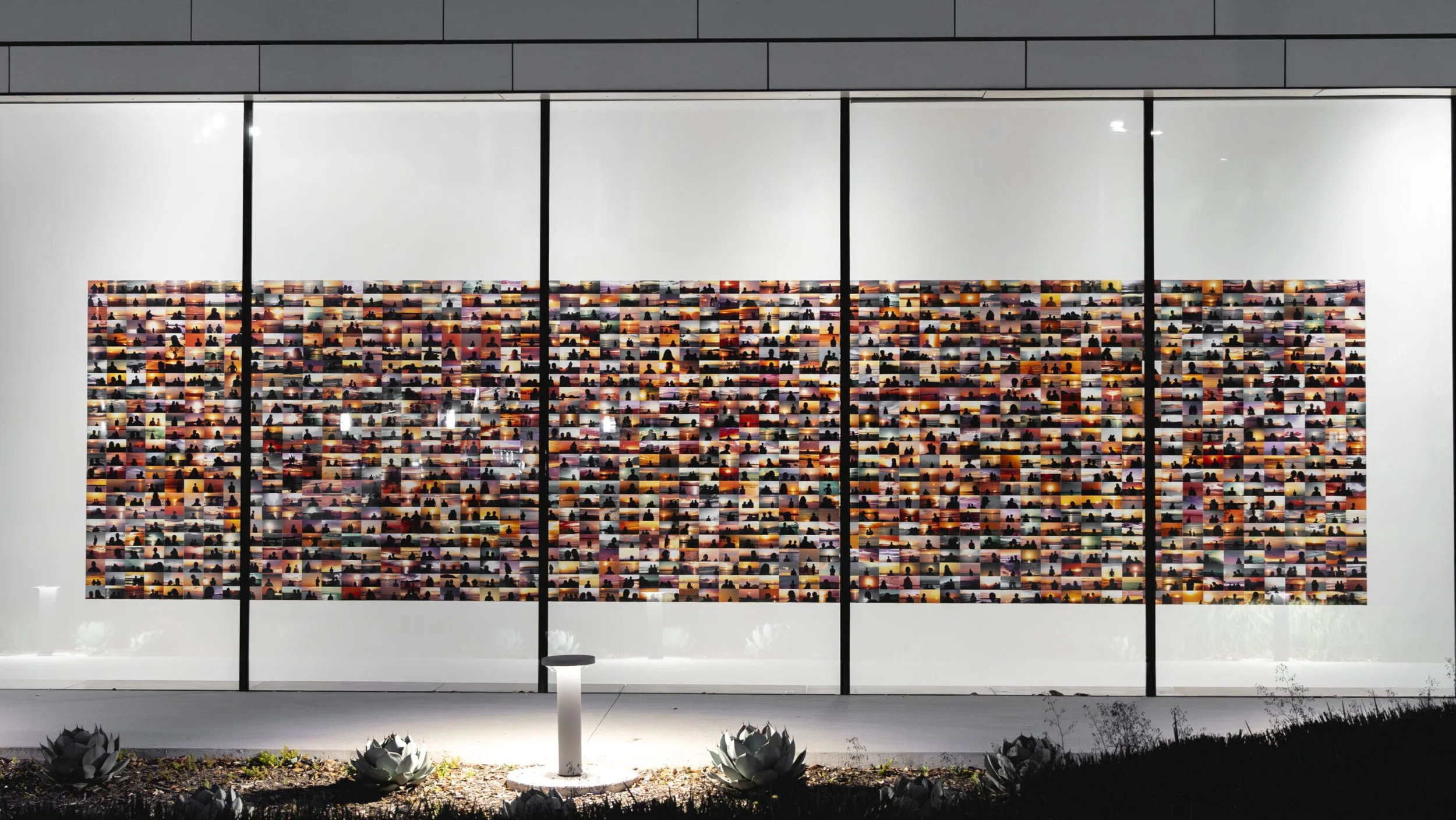We All Watch the Sun: Penelope Umbrico’s 13,243,857 Flickr Photos
There are so many invisible, minute sensations felt across one day that feel tinged with spirituality, but they hardly take on any shape that you can point towards and name before it passes through you. Mono no aware (物の哀れ), a Japanese term that literally means “the pathos of things”, is translated to “a sensitivity to ephemera” or the transient nature of reality. To reclaim this precious, elusive meaning, you might start with the biggest thing that you can see, point towards, and name – the sky. But you still can’t hold it, or even touch it, or make it do anything for you – so you take a photo. It’s an act that is so commonplace and reflexive for a generation whose primary mode of experience is images in constant and nonsensical succession. But it’s also born of a low desperation to access some inner truth via capture and scale – as we may mistake the more permanent, and the bigger, for the more spiritual.
This sense of desperation is alive in Penelope Umbrico’s seminal Sunset Portraits from 13,243,857 Sunset Pictures on Flickr 10/8/13, an art installation comprised of dozens of images of people standing in front of fiery, dusky sunsets sourced from the online photo sharing website. The images look like they were taken by a technologically challenged parent or a naive tourist from an ambiguous location. There are no clues as to where True North is. They shirk any overt or implicit messaging typically conveyed in works depicting man and nature as essentially opposed. There’s no suggestion of manifest destiny or climate accelerationism, only the borders of perception – a horizon cropped by a rectangular aspect ratio, a person’s backlit, blurry silhouette, and white hot, solar rays forced through a tiny aperture.
These images, while flawed, are unafraid to be simply beautiful. The photographer is not trying to create a modern image that is layered with authorship, subtext, and references that might manifest in a clever slogan tee, winking billboard, or esoteric meme. As Dean Kissick remarks on modern image making, “Manufacturing desire has grown more important than creating something beautiful or even desirable.”
Rather, these God-rimmed, information-poor images are an honest attempt at remembering forgotten ideals of nature and beauty, more akin to a Pre-Raphaelite landscape painting or biblical scene. But then something occurs – an artist’s omnipresent hand reaches down from the sky and manipulates these images into an enumerating, composite grid that is then exalted within the white walls of a museum. The energy required to erect and maintain this pristine archive ironically contributes to the slow death of the real thing.
Everyone talks about how fractured society is – how we’re all pacing our echo chambers and can hardly reach a consensus on what reality is and what it is not. But there is also a droning sameness that characterizes online experience, which has become the source material for real life – manifest in Instagram Face, the Apple dance, fashion micro-trends etc. This homogeneity can take on an eerie quality, like passing a row of mannequins or dozens of pairs of bat eyes lit up through the darkness. Umbrico’s work reminded me of Molly Soda’s piece of video art titled “Me Singing Stay by Rihanna”, wherein dozens of Youtube videos of girls covering “Stay” by Rihanna in their bedrooms are compiled and played simultaneously. Vocals are stacked to create a cascading wall of sound that lags over and clashes with itself. These previously solitary rituals become woven into a frenetic web. But one golden thread of melody cuts through the noise, as the lyrics reflect feeling unsure of feeling itself, but at last, inured to its intensity – “something in the way you move…it takes me all the way.”
As information recurs in a memetic loop, what makes us different starts to make us all the same.As a result, we often experience images as ambient flickers of affect that emerge from successive encounters with minor difference from a prescribed template. In other words, images don’t hit, they only prompt you to keep scrolling. This chain of iteration is also reflected in the photo’s SEO friendly alt-text:
Friends running together on beach at sunset
Young woman in straw hat sitting against tree at sunset
Smiling friends drinking cocktails on sunset
Beautiful sad young woman sitting outdoors near the river
Luxury young attractive woman in pink bikini eating watermelon at beach sunset
Sad girl at sunset
Lonely sunset girl
Beautiful young couple relaxing near the sea at sunset
Beautiful couple embracing on the beach
…and so on. I was here, and so were you, maybe in a different way, but at some point our paths overlapped. As Lorde sings, “we order different drinks at the same bar.” The camera lens adjusts for the sun’s exposure, rendering the individuals in the foreground as dark silhouettes rimmed with sunlight, thereby erasing their subjectivity as they experience this awesome event, separately but together. This togetherness is increasingly broken up by screen technology and algorithmic feedbacks, each reflecting and rendering a different but equally vivid version of reality. But in all of our on paper and unquantifiable differences, we all watch the sun.
It is a tranquil thought that the natural wonder of a sunset wields a universalizing force over a divided humanity – but even the sun only sets in the west, and only a sliver of the planet located on the terminator line will experience the same sunset at the same time. Only the internet’s outstretched, blanching rays powered by subterranean cables and orbital satellites could theoretically reach everyone on the planet at once. The sun’s warmth, the source of all life, is subsumed by the dim blue light of the computer screen. But when you zoom out, the composite grid of sunset images begin to look like candy technicolor pixels, reanimated by the optical illusion of twinkling to enact the digital sublime – an overwhelming sense of the world’s scale and complexity brought on by screen technology. The sunset is no longer a trite metaphor for a universal human experience, but we are a metaphor for the sun – we power things. In doing so, we make them appear alive.
The cynical view would be that we are reducing the sun to pixels. The optimistic view would be that the pixels are rendering the sun on demand. But what Umbrico captures through her art is what happens when, via technology, we are allowed to re-commune and experience every gradient of every sunset at the same time, remotely but together.



